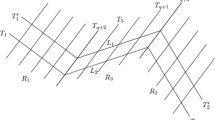Abstract
A latin square is a bachelor square if it does not possess an orthogonal mate; equivalently, it does not have a decomposition into disjoint transversals. We define a latin square to be a confirmed bachelor square if it contains an entry through which there is no transversal. We prove the existence of confirmed bachelor squares for all orders greater than three. This resolves the existence question for bachelor squares.
Similar content being viewed by others
References
T Beth D Jungnickel H Lenz (1986) Design theory Cambridge University Press Cambridge Occurrence Handle0602.05001
T Beth D Jungnickel H Lenz (1999) Design theory EditionNumber2 NumberInSeriesvol. II Cambridge University Press Cambridge
J Dénes AD Keedwell (1974) Latin squares and their applications Akadémiai Kiadó Budapest Occurrence Handle0283.05014
DA Drake GHJ Rees Particlevan WD Wallis (1999) ArticleTitleMaximal sets of mutually orthogonal latin squares Discrete Math 194 87–94 Occurrence Handle1654976 Occurrence Handle10.1016/S0012-365X(98)00119-8 Occurrence Handle0930.05021
Egan JA, Wanless IM (2006) Latin squares with no small odd k-plexes, preprint
AB Evans (2006) ArticleTitleLatin squares without orthogonal mates Des Codes Crypt 40 121–130 Occurrence Handle05075339
D Jungnickel (1990) Latin squares, their geometries and their groups: a survey D Ray-Chaudhuri (Eds) Coding theory and design theory. Part II. Design Theory Springer-Verlag New York 166–225
HB Mann (1944) ArticleTitleOn orthogonal latin squares Bull Amer Math Soc 50 249–257 Occurrence Handle0060.32307 Occurrence Handle10401 Occurrence Handle10.1090/S0002-9904-1944-08127-5
McKay BD, Meynert A, Myrvold W (2006) Small latin squares, quasigroups and loops. J Combin Des to appear http://dx.doi.org/10.1002/jcd.20105
GHJ Rees Particlevan (1990) ArticleTitleSubsquares and transversals in latin squares Ars Combin 29B 193–204 Occurrence Handle0718.05014 Occurrence Handle1046097
Author information
Authors and Affiliations
Corresponding author
Additional information
Communicated by D. Jungnickel
Rights and permissions
About this article
Cite this article
Wanless, I.M., Webb, B.S. The Existence of Latin Squares without Orthogonal Mates. Des Codes Crypt 40, 131–135 (2006). https://doi.org/10.1007/s10623-006-8168-9
Received:
Accepted:
Issue Date:
DOI: https://doi.org/10.1007/s10623-006-8168-9




